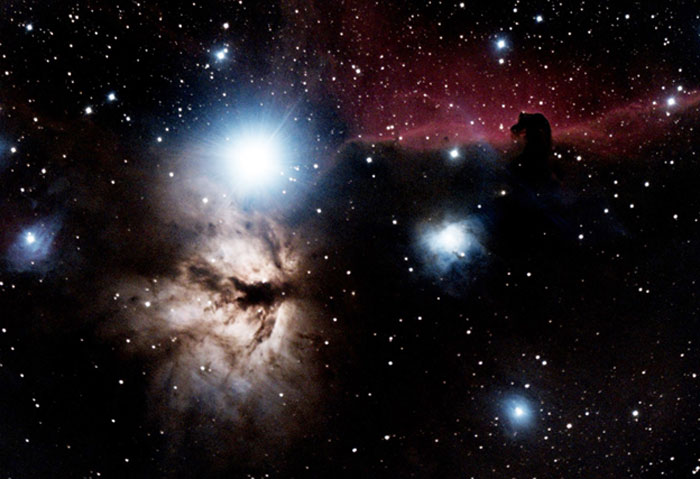November offered great views of nebulae!
This is the Flame (lower left quadrant) and the Horse Head Nebulae (upper right quadrant) and a couple of small reflection nebulae!
The main star in this shot is Alnitak. It’s the easternmost star in Orion’s belt. With a visual magnitude of +1.7, it’s easy to see with the naked eye. Alnitak is about 740 light years away.
To the right of Alnitak, you can see IC 434 and Barnard 33, the Horsehead Nebula. IC 434 is the glowing red emission nebula that lets us see the dark nebula Barnard 33. IC 434 has a visual magnitude of +7.3 and is about 800 light years away from us.
Just below Alnitak lies the Flame Nebula. It’s an emission nebula with a visual magnitude of +10.0. Like the Horsehead Nebula, the Flame Nebula consists of a bright emission nebula that’s obscured by dark nebula in front of it. But in this case, nobody took the time to distinguish the two nebula.
Both of these emission nebulae are clouds of hydrogen gas that are ionized by the ultra-violet light emitted by Alnitak. The dark nebulae are dense dust clouds that block the light of the emission nebula. Apparently, the Flame Nebula has areas of star formation and several bright stars within its boundaries. This might explain why its color is different than the red of IC 434.
What to look for in December 2018.
Mars is the only easily seen planet in the evening skies of December. It you watch it on a nightly basis, you will get to see some retrograde motion. Instead of constantly seeming to move from East to West as the month goes by, Mars will appear to move closer to the eastern horizon. This apparent motion is actually caused by the earth moving away from Mars.
Neptune, Uranus, and Pluto are also visible in the night skies for all of December. With any luck, you might be able to spot Uranus with your naked eye on one of our dark, clear winter nights.
Venus will continue being a spectacular morning star throughout December. You might be able to spot Jupiter and Mercury near the eastern horizon around 6:40 a.m. on December 1. Mercury will appear to be higher in the morning sky for the first ten days of the month, and then it will show retrograde movement and start each morning a little closer to the horizon while Jupiter will rise a little earlier each day. On the 21, the two planets will be in conjunction with each other.
The Geminids Meteor Shower peaks on the night of December 13. This is a major event with up to 120 shooting stars per hour! Look for the twin stars Castor and Pollux in the eastern skies. The meteor shower is best viewed between midnight and dawn, but you might see some activity as early as 9 p.m.
Moon Phases:



